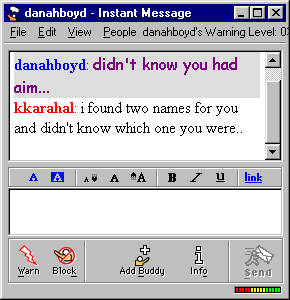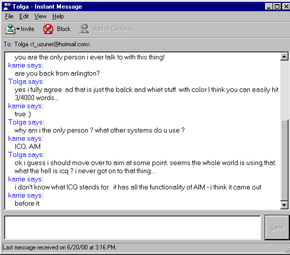|
AIM, MSN, Talk
Space These three systems are also messaging systems similar in many ways to Zephyr and ICQ. Where the big difference arises is in how people view the conversation. In Zephyr and ICQ, the local user sees only the messages sent by the remote users. With AIM, MSN, and talk, the users see essentially the same thing (with talk, it is inverted - the local user is always the top half of the screen). These systems bring the local and the remote into the same space so that the users see the same conversation. AIM is currently available for many platforms and MSN is currently available for windows machines (and requires one to user their passport service). Both have many of the functionalities of Zephyr and ICQ in terms of access restrictions. They both have contact lists and can see who is running the messaging software. They can block certain users. AIM allows the local user to issue warnings to remote users if they are spamming them or sending unwanted messages; given enough warnings a user is removed from the system. The change is in the interface of how the messages from both users is presented. The username of the person is followed by their message, and the visual is sequencial. Both users see what they wrote as well as what was written to them. With AIM, the user can also save a transcript of a conversation for later perusal. This allows for a persistent to a conversation which is more commonaly associated with asynchronous messaging systems such as usenet. Initializing a conversation with talk is different than with the other mentioned messaging systems. With the others, one can observe who is around. That is, who exists in the available space for communication. With talk, one initiates a conversation by typing username@machine-name.domain-name. One must find out beforehand if they are logged on and must know information such as username and machine name from other sources. Another addition made by AIM is the ability to allow more than two people to participate in a conversation. This alters the space from that of a two-person conversation to that of a shared space among multiple users that begins to resemble traditional chat interfaces.
Time AIM and ICQ are instantaneous messaging systems. As soon as the user presses the 'enter' or return' key, the message is sent. This is similar to Zephyr and ICQ. The talk interface appears similar, but is many subtle features. The first is that not only is it synchronous, but it is near-real-time typing. That is, the remote user can observe as you type each character of a word. This allows for conversation behaviors that are more common to those we are familiar with in speach. For example, a conversation in email or AIM is made up of discrete sequencial messages. A user finishes a complete thought and sends the message. With talk, one user can interrupt another user. They can also change the stream of the conversation as they synchronously read what the other user is writing. This is, in a sense, performing sentence or thought repair if they feel they have either not typed the correct thing or if it did not convey what they wished it to. It allows for finer grade nuances to transmit as well as the words of the conversation.
  Figure X. Snapshot from AIM (above). Snapshot from MSN (below).
|